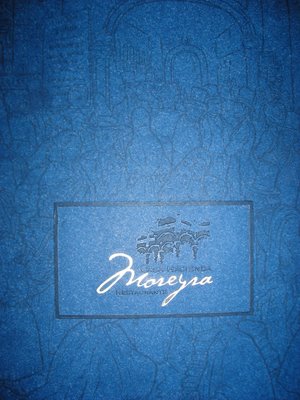
The Casa Hacienda Moreyra is an historic hacienda-style colonial house that has stood in what is now the heart of San Isidro, Lima’s most elegant district, since it was constructed in the 1700s.
During the Colonial period, the Huallas region where San Isidro is located was deeded in a land grant to Nicolás de Rivera. In 1560, Antonio de Rivera, brought some olive seedlings from Spain, but only a few survived. He planted an olive grove, and over time it flourished, and became known as the Bosque del Olivar. By the 1700s,when construction began on the Casa Hacienda, there were over 2,000 olive trees in the Bosque, which today is a short walk from the Casa Hacienda.

The Casa Hacienda's early owners were all members of Lima’s aristocracy. Due to its proximity to the olive groves, upon its completion, the house was initially called the Casa Hacienda El Olivar. The Count of San Isidro acquired the house in 1777. In 1853, the property passed into the hands of Gregorio Paz Soldán, and finally to its current owners, the Moreyra and Paz Soldán families.
The Casa Hacienda Moreyra is a one-story building, built many feet off the ground so its owners could view their lands from the home’s walkways
You enter this imposing building via a large enclosed patio and garden. The moment you enter the property, you are immediately transported far from the hectic pace of central San Isidro. To enter the house itself, you climb a set of double staircases that lead to the main entryway. The chapel and the well are the oldest parts of the house. The house also has a basement and subterranean passageways.

The Casa Hacienda Moreyra has been declared a Historic Monument. Despite earthquakes, restorations, and structural changes, the home has made it into the 21st century relatively intact and true to its original character.
In construction from the 1700s through the early 1800s, it has a variety of architectural elements. There are baroque ornamental features from the Colonial period such as the chapel façade, the carefully detailed window moldings, the elegant carved doors, and the semi-circular archways. There are later neo-Classical touches added to the main building after Peruvian Independence in 1821, and known as Republican style.
Strolling along the walkways, balconies, past the observation tower, and through the spacious and well-appointed rooms, you are transported to another era. The height of the walls provide a sense of space and the open doorways create a free flow of movement from one part of the house to another.
The garden, which completely surrounds the house, is always visible from its windows and creates a feeling of being both indoors and outdoors at the same time. The colored walls, the majestic hand carved doors, and the elegant furnishing, including period antiques, mirrors, and paintings on loan from Peru’s National Institute of Culture, have breathed new life to the Casa Hacienda in its current reincarnation as an elegant restaurant run by the Puga family.
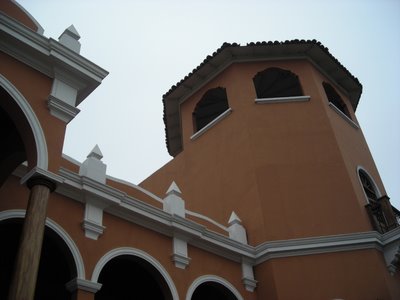
We were told the Counts of San Isidro would climb the tower, from which they could see as far away as the port of El Callao, as well as the towers of the Cathedral, in Central Lima.
There are five distinct dining areas. The more casual outdoor walkway where you dine alfresco, the inviting yellow room, and the very elegant blue and red rooms. There is also an outdoor patio used for special gatherings. While dining, a pianist plays Peruvian waltzes, jazz, and classical pieces on an antique piano.
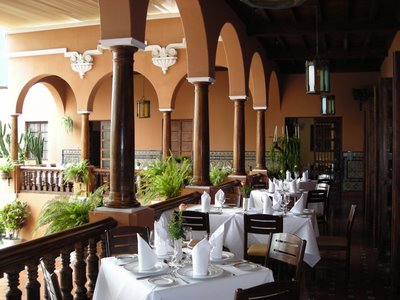
One of the items on the menu that caught my eye was the Argentine prime rib, which is served daily for lunch. The meat is smoked with huarango wood chips from Ica. Then, it is seared quickly at intense heat, and cooked at a low temperature to retain the juices. Before cooking, the prime rib is seasoned with salt from Maras (near Cuzco) and marinated in olive oil.
We saw this cut being presented with a flourish at tableside, served with an herbal potato au gratin, a red wine reduction, and two sauces: coarse mustard and horseradish. The prime rib is best accompanied by a Malbec.
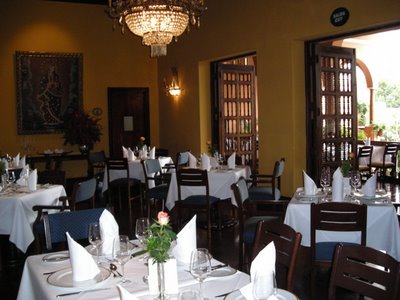
There are many historical anecdotes associated with the Casa Hacienda Moreyra.
One of these involves one of the grande dames of Lima's Viceregal aristocracy, Doña Rosa Gutierrez de Cossío, the Countess of San Isidro, who offered the liberator of Peru, José de San Martín, a reception in the Casa Hacienda.

The celiling in the Casa Hacienda's bar, where we spent most of our visit, is decorated with hand-painted angels. Unfortunately, we did not get a chance to eat at the Casa Hacienda on this trip to Lima. We had stopped by to take an aperitif prior to heading to a different restaurant for lunch. Once there, we regretted having made reservations elsewhere, but since we were meeting people, we couldn’t stay and sample the cuisine.



Upon return from Lima, I have heard mixed reports about the quality of the food. Others who have dined there say that although the food is good, for the price there are better options in Lima. Still, I would return to the Casa Hacienda for a meal the next time in Peru. The atmosphere alone is worth a visit.

I must say, the cóctel de algarrobina we had there was superb and potent, and the service we received was impeccable. Kudos to the hostess who was gracious enough to give us a tour of the Casa Hacienda and fill us in on all the historical details.
Casa Hacienda Moreyra
Avenida Paz Soldán 290, San Isidro
444-3979, 444-4022
Website: Casa Hacienda Moreyra
Peru.Food@gmail.com
.
.
.
Click here for the Peru Food main page.
TAGS: Peru, Peruvian, food, cooking, cuisine, cocina, comida, gastronomía, peruana
TAGS: Peru, Peruvian, food, cooking, cuisine, cocina, comida, gastronomía, peruana
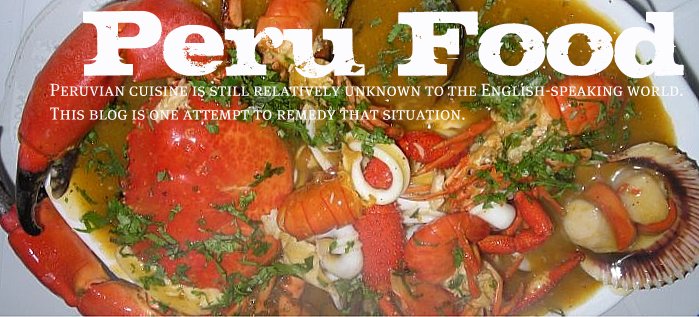
1 comment:
My wife and I ate here July 20, 2008. The food and the service was excellent. We highly recomend it.
Post a Comment